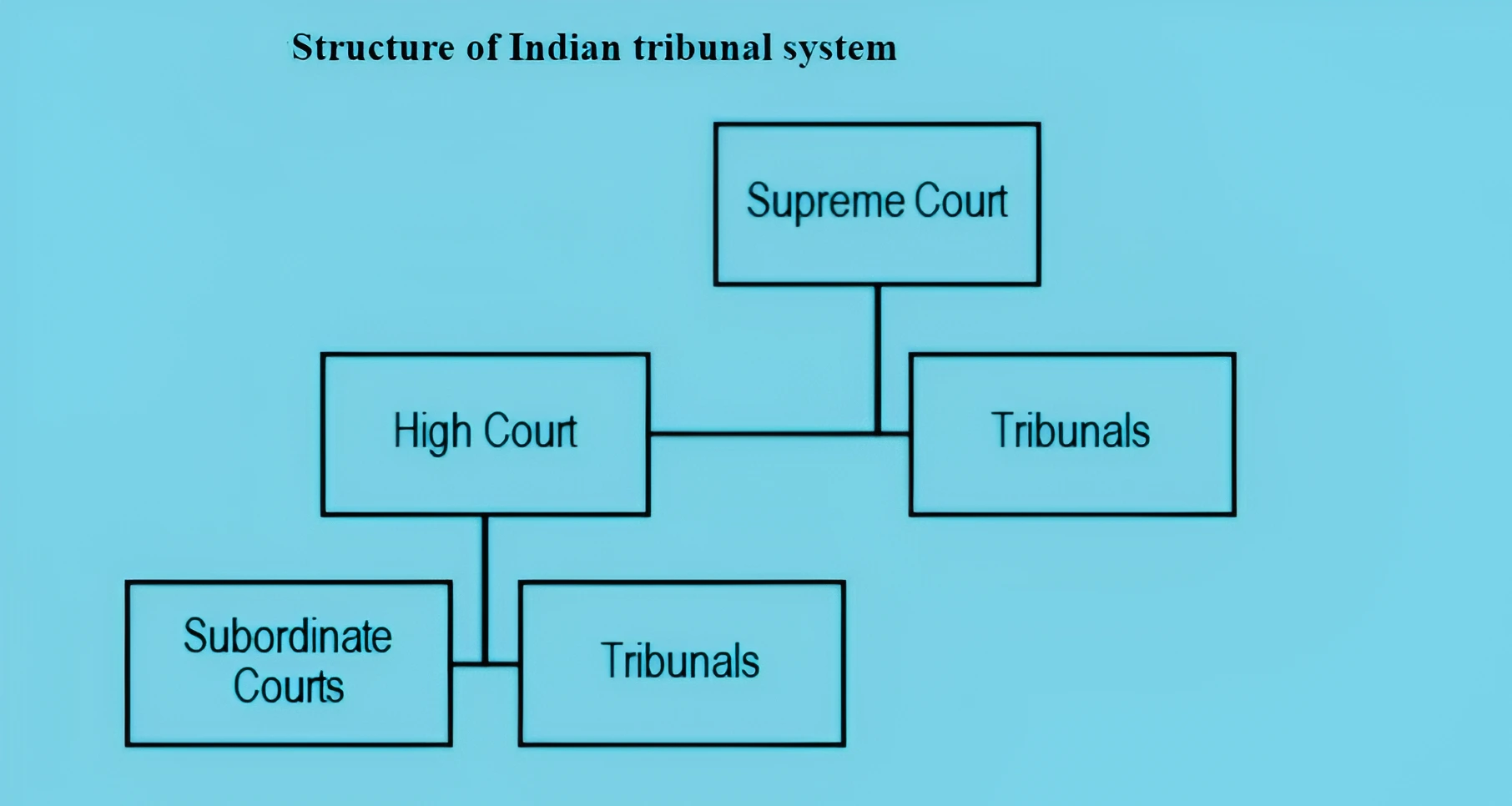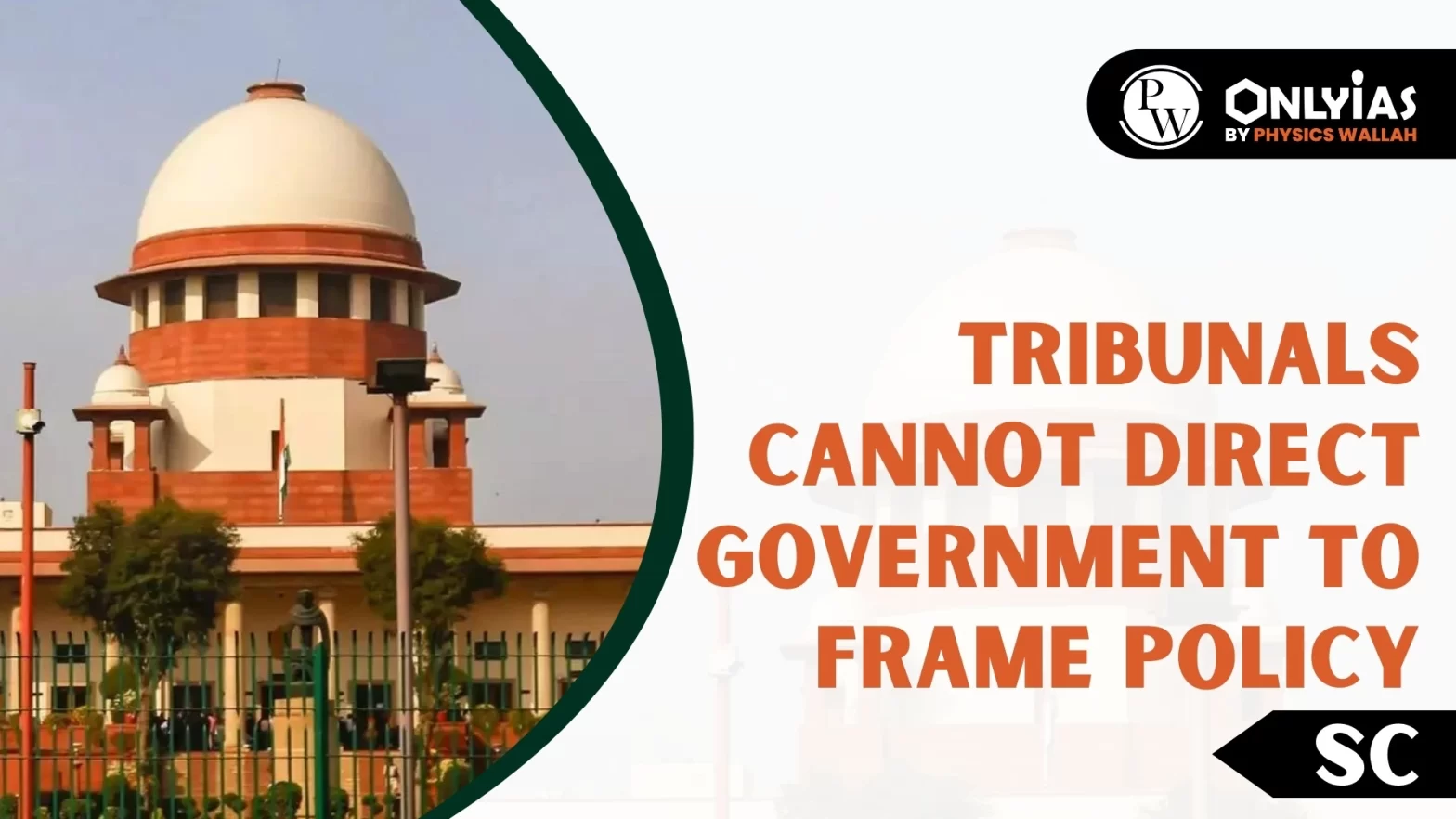Context: This article is based on the news “Supreme Court rules that tribunals cannot direct government to frame policy” which was published in the Hindu. The Supreme Court has outlined that tribunals, when operating within the confines of their governing legislations, lack the authority to compel the government to formulate policies.
Armed Forces Tribunal Cannot Direct Govt to Formulate Policy: SC
- The Supreme Court clarification arose in the context of the Armed Forces Tribunal (AFT) directing the government to establish a policy for appointing the Judge Advocate General.
- The judgment said the creation or sanction of a scheme or policy regarding the service of defense personnel or their regularization was the “sole prerogative of the government”.

About Armed Forces Tribunal (AFT)
- The Armed Forces Tribunal has been set up under the Armed Forces Tribunal Act, 2007.
- Objective:
- To provide for the adjudication of disputes and complaints with respect to commission, appointments, enrolment and conditions of service in respect of persons subject to the Army Act, 1950, the Navy Act, 1957 and the Air Force Act, 1950
- To provide for appeals arising out of orders, findings or sentences of courts-martial held under the said Acts and for matters connected therewith or incidental thereto
|
About Tribunals in India
- Tribunals are institutions established for discharging judicial or quasi-judicial duties.
- Objective: To reduce the caseload of the judiciary or to bring in subject expertise for technical matters.
- Constitutional Provisions: In 1976, Articles 323A and 323B were inserted in the Constitution of India through the 42nd Amendment.
- Article 323A empowered Parliament to constitute administrative Tribunals (both at central and state level) for adjudication of matters related to recruitment and conditions of service of public servants.
- Under Article 323 B, the Parliament and the state legislatures both are authorized to provide for the establishment of tribunals for the adjudication of disputes relating to the following matters:
- Taxation, Foreign exchange, import and export, Industrial and labor, Land reforms
- Currently, tribunals have been created both as substitutes to High Courts and as subordinate to High Courts.
- In the former case, appeals from the decisions of Tribunals (such as the Securities Appellate Tribunal) lie directly with the Supreme Court.
Central Administrative Tribunal (CAT)
- CAT was set up in 1985 with the principal bench at Delhi.
- The CAT is a multi-member body consisting of a chairman and members
- The CAT exercises original jurisdiction in relation to recruitment and all service matters of public servants covered by it.
- Its jurisdiction extends to the all-India services, the Central civil services, civil posts under the Centre and civilian employees of defense services.
State Administrative Tribunals:
- The Administrative Tribunals Act of 1985 empowers the Central government to establish the State Administrative Tribunals (SATs) on specific request of the concerned state governments.
- The chairman and members of the SATs are appointed by the President after consultation with the governor of the state concerned.
|
-
- In the latter case (such as the Appellate Board under the Copyright Act, 1957), appeals are heard by the corresponding High Court.
- Need for Tribunals:
- They intend to provide a platform for faster adjudication as compared to traditional courts, as well as expertise on certain subject matters.
- As per data retrieved from the Integrated Case Management System (ICMIS) by the Supreme Court of India, as on July 1, 2023 there are 69,766 cases pending in the Supreme Court.
Timeline: Indian Tribunal System
- 1941: The Income Tax Appellate Tribunal was established as the first Tribunal in India.
- 1969: The First Administrative Reforms Commission recommended that the central government should set up Civil Services Tribunals at the national level and state levels.
- 1974: The Sixth Law Commission (1974), recommends setting up a separate high-powered tribunal and commission for adjudication of matters in High Courts.
- 1976: The 42nd amendment empowered Parliament to constitute:
- administrative tribunals (both at central and state level) for adjudication of matters related to recruitment and conditions of service of public servants;
- other tribunals for adjudication of certain subject matters including industrial disputes, taxation (such as levy and collection of taxes), and foreign exchange.
- 2017: The Finance Act, 2017 reorganized the tribunal system by merging tribunals based on functional similarity. The number of Tribunals was reduced from 26 to 19
The Armed Forces Tribunal
- AFT was established under the Armed Forces Tribunal Act 2007, with the power provided for the adjudication or trial by Armed Forces Tribunal of disputes and complaints with respect to commission, appointments, enrolments and conditions of service in respect of persons subject to the Army Act, 1950, The Navy Act, 1957 and the Air Force Act, 1950.
- It can further provide for appeals arising out of orders, findings or sentences of courts- martial held under the said Acts and for matters connected therewith or incidental thereto.
- Principal Bench: New Delhi
- Regional Benches: Chandigarh, Lucknow, Kolkata, Guwahati, Chennai, Kochi, Mumbai, Jabalpur, Srinagar and Jaipur.
- Composition: Each Bench comprises of a Judicial Member and an Administrative Member.
- The Judicial Members are retired High Court Judges and
- Administrative Members are retired Members of the Armed Forces who have held rank of Major General/ equivalent or above for a period of three years or more,
- Judge Advocate General (JAG), who have held the appointment for at least one year are also entitled to be appointed as the Administrative Member.
- Rule and Procedure: The Tribunal shall transact their proceedings as per the Armed Forces Tribunal (Procedure) rules, 2008. The Tribunal will normally follow the procedure as is practiced in the High Courts of India.
Challanges with Tribunals
- Constitutional Competence of Tribunals: The constitutional standing of tribunals has been questioned. In particular, whether the jurisdiction of High Courts and Supreme Court can be removed.
- For Example: In 1986, the Supreme Court ruled that Parliament may create an alternative to High Courts provided that they have the same efficacy as the High Courts.
- Independence of tribunals: In 2010, the Supreme Court noted that the tribunals in India have not achieved complete independence.
| Key Supreme Court Judgements related to tribunals |
Principles specified |
- S. P. Sampath Kumar Etc. versus Union of India and Ors., 1986
|
- It is constitutionally valid for Parliament to create an alternate institution to High Courts with jurisdiction over certain matters provided that the alternate body has the same efficacy as that of the High Court.
|
- R. Gandhi versus Union of India & Anr, 2010
|
- Parliament may create an alternate mechanism to High Courts on subject matters in the Union List.
|
- Madras Bar Association versus Union of India, 2020
|
- National Tribunals Commission should be set up to supervise appointments, as well as functioning and administration of tribunals.
|
- Madras Bar Association versus Union of India, 2021
|
- The Court struck down provisions related to the four-year tenure and minimum age requirement of 50 years for members.
|
-
- In 2014, the Supreme Court while reviewing the National Tax Tribunal Act, 2005 stated that when a tribunal is vested with jurisdiction of High Courts, the tribunal must be free from executive interference.
- Persistent Vacancies in Key Tribunals: The Standing Committee on Personnel, Public Grievances, Law and Justice (2015) had noted that several tribunals (such as Cyber Appellate Tribunal and Armed Forces Tribunal) have vacancies which makes them dysfunctional.
- As of March 3, 2021, there were 23 posts vacant out of total 34 sanctioned strength of judicial and administrative members in the Armed Forces Tribunal.
- Lack of Specified Procedure: The administrative adjudicatory bodies do not have any rigid set of rules and procedures. Thus, there is a chance of violation of the principle of natural justice.
- Increasing Pendency of Cases: As per report of Parliamentary Standing Committee on Personnel, Public Grievances, Law and Justice. As many as 80,545 cases are pending in different benches of the tribunal as on December 31, 2022 in CAT.
- Of these, 16,661 cases are pending for zero to one year, 46,534 for one to five years, 16,000 for five to 10 years and 1,350 for more than 10 years,
- Inadequate infrastructure: Many tribunals also do not have adequate infrastructure to carry out their functions efficiently which leads to high pendency rates thus proving unfruitful to deliver quick justice.
Way Forward
- National Tribunal Connection: The 74th report of the Parliamentary Standing Committee on Law, released in 2023, recommended the creation of an NTC to address concerns such as the selection process, set eligibility criteria for appointment, etc.
- Judicial Impact Assessment: In 2019, while reviewing the amalgamation of tribunals, the Supreme Court stated that judicial impact assessment should be conducted to analyze the amalgamation of tribunals.
- Qualifications: In Union of India vs. R. Gandhi , the Supreme Court outlined that when the existing jurisdiction of a court is transferred to a tribunal, its members should be persons of a rank, capacity and status as nearly as possible equal to the rank, status and capacity of the court.
- Independence: The administrative support for all Tribunals should be from the Ministry of Law & Justice.
- Neither the Tribunals nor its members shall seek or be provided with facilities from the respective sponsoring or parent Ministries or concerned Department.
- Case Management System: Tribunal should adopt an Advance Case Information system that facilitates the hearing of cases through video-conferencing and complete digitization of the functioning of the tribunal.
- For Example, The National Judicial Data Grid (NJDG) is an online database which was establised as part of the “eCourts Project” in 2020.
Conclusion:
The Supreme court judgment serves as a reminder of the importance of respecting the boundaries and harmonious interplay between tribunals and the government, promoting a balanced legal framework and reinforcing the principles of democratic governance.
To get PDF version, Please click on "Print PDF" button.


